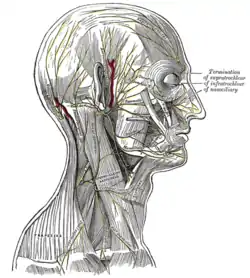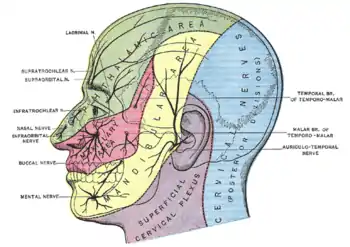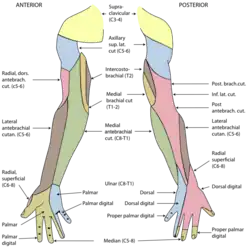Supraclavicular nerves
The supraclavicular nerve is a cutaneous (sensory) nerve of the cervical plexus that arises from the third and fourth cervical (spinal) nerves. It emerges from beneath the posterior border of the sternocleidomastoid muscle, then split into multiple branches. Together, these innervate the skin over the shoulder.
| Supraclavicular nerves | |
|---|---|
 The nerves of the scalp, face, and side of neck. (Supraclavicular nerves visible at bottom.) | |
 Plan of the cervical plexus. (Superficial descending labeled at bottom left.) | |
| Details | |
| From | C3–C4 of cervical plexus |
| Innervates | Cutaneous innervation of the skin above and below the clavicle. |
| Identifiers | |
| Latin | nervi supraclaviculares |
| TA98 | A14.2.02.024 |
| TA2 | 6391 |
| FMA | 65414 |
| Anatomical terms of neuroanatomy | |
The supraclavicular nerve can be blocked during shoulder surgery.
Anatomy
Origin
The supraclavicular nerve is a branch of the cervical plexus[1] that arises from cervical (spinal) nerves C3-C4[2][1] with the predominant contribution from C4.[1]
Course
It emerges at the posterior border of the sternocleidomastoid muscle alongside the other three cutaneous branches of the cervical plexus, then promptly divides into several branches.[1] The nerves descend in the posterior triangle of the neck beneath the platysma muscle and the deep cervical fascia. Near the clavicle, the supraclavicular nerves perforate the fascia and the platysma muscle to become cutaneous. They are arranged, according to their position, into three groups—anterior, middle, and posterior.[2]
Medial supraclavicular nerves
The medial supraclavicular nerves or anterior supraclavicular nerves (nn. supraclaviculares anteriores; suprasternal nerves) cross obliquely over the external jugular vein and the clavicular and sternal heads of the sternocleidomastoideus, and supply the skin as far as the middle line. They furnish one or two filaments to the sternoclavicular joint.[3]
Intermedial supraclavicular nerves
The intermedial supraclavicular nerve middle supraclavicular nerves (nn. supraclaviculares medii; supraclavicular nerves) cross the clavicle, and supply the skin over the pectoralis major and deltoideus, communicating with the cutaneous branches of the upper intercostal nerves.
Lateral supraclavicular nerves
The lateral supraclavicular nerve or posterior supraclavicular nerves[4] (nn. supraclaviculares posteriores; supra-acromial nerves) pass obliquely across the outer surface of the trapezius and the acromion, and supply the skin of the upper and posterior parts of the shoulder.
Clinical significance
A supraclavicular nerve block is useful when performing surgery on the shoulder, anaesthetising a large area of skin.[5]
The supraclavicular nerves are vulnerable during surgery on the clavicle, and must be identified early on in surgeries to reduce the risk of nerve injury and neuroma.[6]
Additional images
 Dermatome distribution of the trigeminal nerve
Dermatome distribution of the trigeminal nerve Cutaneous nerves of right upper extremity.
Cutaneous nerves of right upper extremity. Diagram of segmental distribution of the cutaneous nerves of the right upper extremity.
Diagram of segmental distribution of the cutaneous nerves of the right upper extremity. Side of neck, showing chief surface markings.
Side of neck, showing chief surface markings.
References
![]() This article incorporates text in the public domain from page 928 of the 20th edition of Gray's Anatomy (1918)
This article incorporates text in the public domain from page 928 of the 20th edition of Gray's Anatomy (1918)
- Sinnatamby, Chummy S. (2011). Last's Anatomy (12th ed.). pp. 333–335. ISBN 978-0-7295-3752-0.
- Rea, Paul (2016-01-01), Rea, Paul (ed.), "Chapter 3 - Neck", Essential Clinically Applied Anatomy of the Peripheral Nervous System in the Head and Neck, Academic Press, pp. 131–183, ISBN 978-0-12-803633-4, retrieved 2021-01-06
- IMAIOS–supraclavicular
- Biology-online
- Neal, Joseph M. (2008-01-01), Benzon, Honorio T.; Rathmell, James P.; Wu, Christopher L.; Turk, Dennis C. (eds.), "Chapter 47 - Upper Extremity Blocks", Raj's Practical Management of Pain (Fourth Edition), Philadelphia: Mosby, pp. 871–887, ISBN 978-0-323-04184-3, retrieved 2021-01-06
- Chase, S.; Menendez, M. E.; Ring, D. C. (2015-01-01), Greiwe, R. Michael (ed.), "18 - Clavicle nonunion and malunion", Shoulder and Elbow Trauma and its Complications, Woodhead Publishing Series in Biomaterials, Woodhead Publishing, pp. 389–402, ISBN 978-1-78242-449-9, retrieved 2021-01-06
External links
- lesson6 at The Anatomy Lesson by Wesley Norman (Georgetown University)